Prime rib is an expensive cut of beef, so the last thing you need is to under or over cook it! This recipe turned out even better than I had hoped! The beef turned out moist, with a crunchy outer crust, and it was cooked exactly the way we like it!

For our Christmas Eve Dinner, this year, I took a detour from our more traditional German menu.
At first, a few of my family members were disappointed– until I said I was going to make Prime Rib. It’s pretty unanimous that Prime Rib is something my entire family loves to eat. My husband– not so much. He says that Prime Rib has a “rubbery texture”. His loss, our gain!
Okay. I’ll bite. I’ve made the mistake of ordering a Prime Rib Dinner at a restaurant that doesn’t specialize in this expensive cut of beef. I agree. I’ve had some less-than-stellar prime rib that’s tough and chewy..
We like our Prime Rib medium rare…pink, please and thank you. I don’t want all kinds of herbs and heavy doses of garlic. A local restaurant makes a GREAT prime rib. This place uses only salt & pepper… and they aren’t shy with the salted crust. O.M.G. The crust is crunchy, and perfectly seasoned. It’s a dinner ecstasy, that only a Prime Rib lover can understand. I was on a mission to make our own, at home.
Making your own prime rib at home can be a little bit scary. I say this, because it’s an expensive cut of meat. Granted, it’s not quite as expensive to buy as a quality grass-fed Filet Mignon. I would hate to ruin this beautiful roast by overcooking it!
A few years ago, I tried the method of roasting a Prime Rib at very high heat, and then shutting off the oven. It was a dismal fail, even though I didn’t open up the oven for anything in the world. It was raw. So dinner was delayed, and side dishes kept warm. All turned out okay, but I wanted to see what other methods there were.
America’s Test Kitchen/Cooks Illustrated came through with their version of “The Best Prime Rib”. This method is a bit different, in that we cut off the bone, and set it aside.
The fat cap is scored and two tablespoons of coarse salted is rubbed in. The roast is set right back, on top of the bones, and then set into the refrigerator to dry age for at least one day– up to four days. (Here, I’ve tied the roast together to dry- age, but that step isn’t necessary. (I **ahem** didn’t read the directions right.)
It’s five hours before dinner should be ready. Remove the roast, and let it come to room temperature for a couple of hours. The bones are set aside, and set a 12″ skillet to high, with a bit of vegetable oil. Yes, we are going to sear!
The roast is seared, starting with fat side down, and all the way around– with the exception of the bottom half that will be laid on top of the bones again.
The roast is on top of the bones. Tie it all together (very easy to do, by the way…just slip the cooking twine underneath the bones and roast, and slide under– kinda like flossing!) Add pepper, set atop a wire rack that is fitted on top a rimmed baking sheet– and get ready to slip this into a 250F preheated oven.
NOTE: Can you add fresh herbs, olive oil and garlic? Yes, I suppose you could. See my TASTING NOTES at the end of this post for more info.
What method has America’s Test Kitchen come up with and why? Here are their own words:
Why this recipe works:
The perfect prime rib should have a deep-colored, substantial crust
encasing a tender, juicy rosy-pink center. To achieve this perfect
roast, we started by salting the roast overnight. The salt enhanced the
beefy flavor while dissolving some of the proteins, yielding a
buttery-tender roast. To further enhance tenderness, we cooked the roast
at a very low temperature, which allowed the meat’s enzymes to act as
natural tenderizers, breaking down its tough connective tissue. A brief
stint under the broiler before serving ensured a crisp, flavorful crust.
If you don’t own a reliable meat thermometer, I can assure that it’s an investment that you will not regret. I bought a Thermapen 15 years ago ($96.00) and it has become my most dependable friend in the kitchen. I can trust the internal temperature, which shows up faster than you can blink your eye!
The goal was to slowly roast the prime rib until it reached an internal temperature of 110F. Because I had to use a meat thermometer, I removed the roast from the oven and quickly shut the door. The roast was at 112F. Whew!
Turn off the oven, and let this continue to cook– obviously– don’t open the oven door!
4-1/2 hours later, my family had already arrived, and there was a lot of activity and lively conversation going on. I removed the roast and my meat thermometer registered as 127F. I say a silent prayer of gratitude, and set the prime rib on a carving board to rest for 30 minutes, covered with foil– while I finish up the Creamed Spinach with a crunchy Panko Herb Topping (recipe to come)…
…and the Make-Ahead Mashed Potatoes. My 60-Minute Dinner Rolls are popped into the now vacant the oven…
Right before it’s time to carve the Prime Rib, turn the boiler on and pop the roast underneath the broiler for about 3 minutes. It comes out sizzling and crunchy… there are ooh’s and ahhhhhh’s as I set the roast out to be carved. (I thought this was a brilliant step from ATK. Of course the crust had softened, from the steam as the meat was covered with foil.) Broiling the outside, again, crisped it right up! As I cut off the twine, and removed the bone, I have to give props that carving is now a cinch. I don’t have to deal with cutting the bone off…as it’s already been done!
Please forgive the overexposed photos. It’s dark outside, and I don’t have the room (nor extra time) to set up my props to bounce light…etc.
All I can say is “yes, yes, yes!!!” This is cooked exactly the way the majority of my guests love (save one, who quickly claims an end cut).
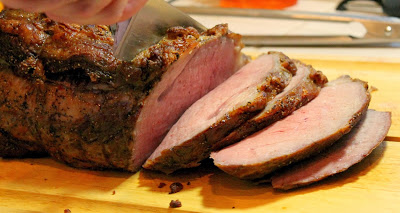
I am beaming with joy and gratitude that this recipe really works– and I wouldn’t expect less from America’s Test Kitchen.
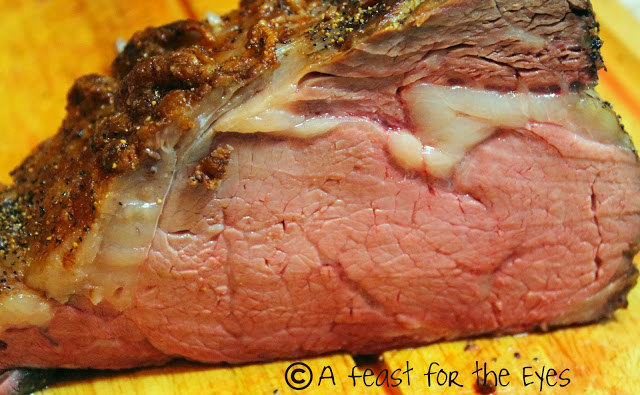
There were seven of us, and this large chunk of prime rib (leftover) was quickly hidden out of view. What? Believe me, everyone had plenty of food on their plate! This, my friends, was destined for Prime Rib sandwiches, the following day.
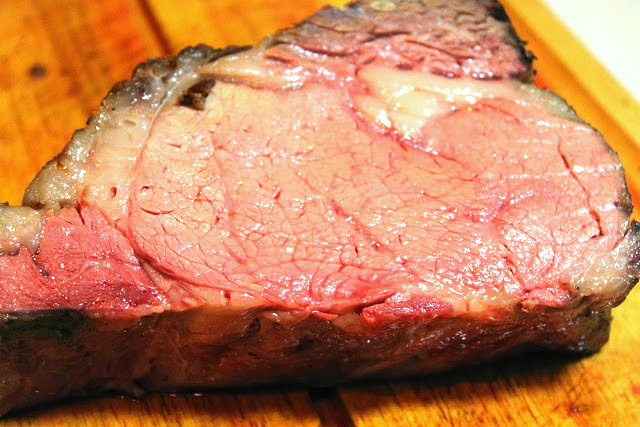
I had a lovely white platter that I served the Prime Rib slices on my festively decorated dinner table. As always, there was just to much excitement and activity going on– that I just couldn’t take photos of our plated dinner– other than these. But you get the idea.
TASTING NOTES: Be sure that you buy a prime-grade beef, with an untrimmed fat cap (if possible). I cannot stress enough how important it is to have a good meat thermometer, so you don’t have to fret or guess if the meat is cooked enough– let alone, overcooked! If you follow these steps, exactly, you will end up with a tender slice of Prime Rib that is moist and perfectly seasoned.
My husband… he said it was tender and delicious and not at all rubbery! That’s a great endorsement, if I ever heard one.
The only “downside” to this method, is that I didn’t get lot of juices to make my own au jus. Somehow, I managed to deglaze the pan to scrape off just a little bit of fond– not much– and using a quality beef stock, I got just a little bit of au jus.
NOTES: The bones– they aren’t roasted enough to gnaw on. All is not wasted. I’ll be roasting these to make some beef stock. Nothing went to waste. Win!
I’ve had Prime Rib that has been slow-roasted with rosemary, thyme and garlic. It’s quite good. But, personally, I prefer to allow salt & pepper to be my only seasoning so that the prime rib is the star of this show. Your choice.
This method will remain my “go to” recipe for making Prime Rib. In a way, this method is very similar to one of my most viewed recipes for “Slow Roasted Beef“– which also comes from the fine folks of America’s Test Kitchen/Cook’s Illustrated.
I feel so blessed to be able to treat my family to a dinner like this. They appreciated every single bite. Christmas Eve, at our home, was a total success!
Perfect Prime Rib
Ingredients
- 7 pounds beef standing rib roast (3 bones), meat removed from bones, bones reserved
- Kosher salt and ground black pepper
- 2 teaspoons 2 teaspoons vegetable oil
Instructions
- To remove the bones from the roast, use a sharp knife and run it down the length of the bones, following the contours as closely as possible until the meat is separated.
- Using sharp knife, cut slits in surface layer of fat, spaced 1 inch apart, in crosshatch pattern, being careful to cut down to, but not into, meat. Rub 2 tablespoons salt over entire roast and into slits. Place meat back on bones (to save space in refrigerator), transfer to large plate, and refrigerate, uncovered, at least 24 hours and up to 96 hours.
- Adjust oven rack to middle position and heat oven to 200°F.
- Heat oil in 12-inch skillet over high heat until just smoking. Sear sides and top of roast (reserving bone) until browned, 6 to 8 minutes total (do not sear side where roast was cut from bone).
- Place meat back on ribs, so bones fit where they were cut, and let cool 10 minutes; tie meat to bones with 2 lengths of twine between ribs. Transfer roast, fat side up, to wire rack set in rimmed baking sheet and season with pepper. Roast until meat registers 110°F, 3 to 4 hours.
- Turn off oven; leave roast in oven, opening door as little as possible, until meat registers about 120°F for rare or about 125°F for medium-rare, 30 to 75 minutes longer. If the roast has not reached the correct temperature in this time range, heat the oven to 200°F, wait 5 minutes, then shut it off and continue to cook the roast until it reaches the desired temperature.
- Remove roast from oven (leave roast on baking sheet), tent loosely with aluminum foil, and let rest for at least 30 minutes and up to 75 minutes.
- Adjust oven rack about 8 inches from broiler element and heat broiler. Remove foil from roast, form foil into 3-inch ball, and place under ribs to elevate fat cap. Broil until top of roast is well browned and crisp, 2 to 8 minutes.
- Transfer roast to carving board; cut twine and remove roast from ribs. Slice meat into 3/4-inch-thick slices. Season with coarse salt to taste, and serve.
Notes
Nutrition


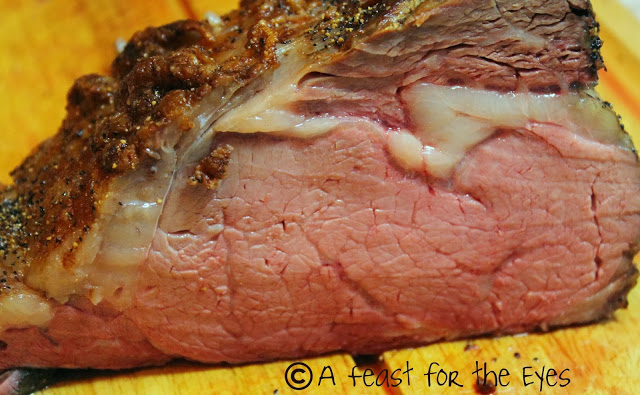




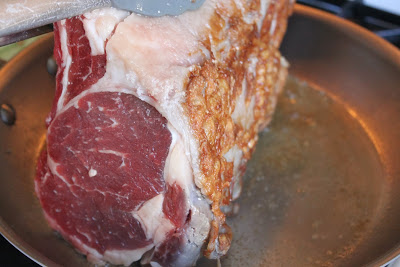

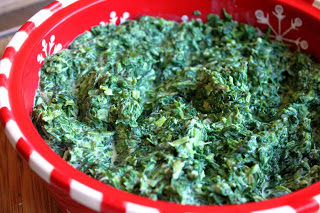


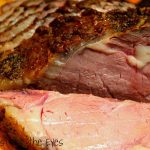

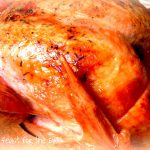
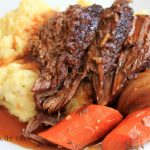


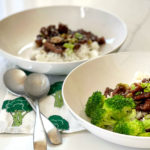
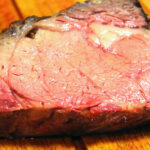
The only time I ever made a rib roast I used the method of cooking it long and slow and then blasting it at the end. It could not have been more perfect. You are giving me such a craving now.
you have me craving some yorkshire pudding, whipped potatoes and gravy with some tender prime cut.
Prime rib has definitely traditionally been a popular Christmas dinner item also!! Looks like you cooked it to perfection!
Oh Deb, This was truely a feast for my eyes! You cooked it perfectly and it looks and sounds amazing.I haven't cooked one in years because I'm stressed I will over or undercook it.I'll take your word on this one for sure!
I’m SO happy I found you! Ive made prime rib several times before, and it usually turns out ok. But it’s not something I cook very often, and I usually forget exactly which recipe I used. So, I did a search and found your blog and was thrilled that you used Arm’s method! I’m a big ATK aficionado, and have their cookbook, so out it came. I followed exactly what you said to do. I did use an oven temp of 225, b/c ATK said to cook at 200 deg and I was afraid it would be too low. I think after cooking for the 4 hrs, my roast was 117 deg. (A little high, but not too bad). When I took it out after about 30 min with the oven off, it tempted at 126 deg. It turned out PERFECT! AND delicious! I also used your 60 minute dinner rolls (I’m not a very avid baker and my dinner rolls usually end up in the garbage b/c they turn out like doorstop), and they turned out PERFECT too!
I have to share with you b/c you mentioned how valuable a Thermapen is…a couple of years ago when we were having the wildfires in Napa, we were told to be ready to evacuate at a moment’s notice. I had 2 dogs at the time, so I got all their stuff ready to pack in the car. I looked around, thinking that all the beautiful things I’ve accumulated over the years (especially my collection of classic cookbooks…it was overwhelming to even begin to think about ANYTHING that MORE valuable than others, and I couldn’t fit much in my small car anyway. So the ONLY thing I grabbed to take with me, was my THERMAPEN, ROFL. I still laugh when I think about it. Luckily, my home was fine and we never had to evacuate.
Thanks for choosing great recipes and your great commentary on them; it’s so helpful😊!
That was supposed to be ATK’s not Arm’s 😏
What a wonderful story to read. I’m so glad your home didn’t suffer! Thank you for the compliments. Thank you for stopping by!
Thank you for sharing your recipe. Great technique – my roast turned out wonderfully! I’d love to know how you’d adjust this recipe for a smaller roast (~ 3 lbs) meant for two or three people.
I’m so glad to read that this recipe worked for you. I’ve never made this for a smaller roast, so I would be guessing as much as you would. Sorry. However, I always roast by temperature and that’s what I go by.